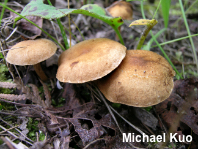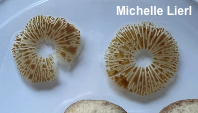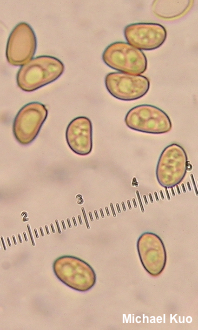| Major Groups > Gilled Mushrooms > Dark-Spored > Tubaria |

|
[ Basidiomycota > Agaricales > Tubariaceae . . . ] The Genus Tubaria by Michael Kuo, 8 May 2023 Go ahead. Think of something interesting and witty to say about the genus Tubaria. I'll wait. . . . Yeah; that's what I thought. I flirted with "tube area" for a while and got nowhere. "Kyle O. Cystidia" was a non-starter. The truth is, tubarias are boring unless you're fond of microscopy—and even then, well, let's just say it's a challenge to stay focused. Among the hordes of LBMs (Little Brown Mushrooms) out there, species of Tubaria can be recognized by their microscopic features: the spores are smooth or nearly so, pale brown, and lack a germ pore (additionally they often collapse in KOH and Melzer's); the cheilocystidia are prominent and thin-walled; and the pileipellis is a cutis. Macroscopically the mushrooms are fairly small, the gills are broadly attached to the stem or begin to run down it, and there is often evidence of a partial veil on the cap or stem. However, these macroscopic features apply to many other genera as well, so microscopic examination is usually required even for identification to genus. Because no one cares about tubarias, they are poorly documented in North America, outside of the "field guide species," Tubaria confragosa and Tubaria furfuracea. Type collections of putative North American Tubaria species go unstudied. Online records are identified without reference to microscopic features, let alone DNA sequencing. Thus the portrait "Tubaria in North America" is more of an Impressionist work than an example of Photographic Realism. Features used in Tubaria identification include mushroom size, colors, and disposition of veil remnants—as well as microscopic features (especially the morphology of cheilocystidia and spores). I recommend you try identifying tubarias with robust collections of several to many mushrooms, representing various stages of development, all collected in the same location. |
|
|
Key to 9 Tubaria Species in North America
References Alcántara, D. M. (2023). Aportaciones Micológicas 55. Micobotánica-Jaén 16: 1. Retrieved 20 April 2023 from: https://www.micobotanicajaen.com/Revista/Articulos/DMerinoA/Aportaciones055/Aportaciones55.pdf Antonín, V., J, Kramoliš & M. Tomšovsky (2012). Two collections of albinotic forms of Tubaria (Basidiomycota, Agaricales, Inocybaceae). Czech Mycology 64: 197–208. Kühner, R. & H. Romagnesi (1953). Flore analytique des champignons superieurs (agarics, bolets, chanterelles). Paris: Masson. 556 pp. Læssøe, T. L. & J. H. Petersen (2019). Fungi of Temperature Europe (in 2 volumes). Princeton, NJ: Princeton University Press. 1715 pp. Matheny, P. B., E. C. Vellinga, N. L. Bougher, O. Ceska, P. -A. Moreau, M. A. Neves & J. F. Ammirati (2007). Taxonomy of displaced species of Tubaria. Mycologia 99: 569–585. Migliozzi, V. & P. -A. Moreau (2004). Entità interessanti dell'Italia centrale, primero contributo: Tubaria praestans. Bollettino del Gruppo Micologico G. Bresadola 47: 1–7. Moser, M. (1983). Keys to Agarics and Boleti (Polyporales, Boletales, Agaricales, Russulales). Ed. Kibby, G. Transl. Plant, S. London: Roger Phillips. 535 pp. Vesterholt, J. (2018). Tubaria (W. G. Sm.) Gillet. In Knudsen, H. & J. Vesterholt, eds. Funga Nordica: Agaricoid, boletoid, clavarioid, cyphelloid and gastroid genera. Copenhagen: Nordsvamp. 974–976. Vila, J., P. -A. Moreau, M. Tabarés, J. Carbó & M. À, Pérez-de-Gregorio (2007). Tubaria decurrens, une espèce américaine redécouverte en Europe. Cryptogamie, Mycologie 28: 1–11. This site contains no information about the edibility or toxicity of mushrooms. Cite this page as: Kuo, M. (2023, May). The genus Tubaria. Retrieved from the MushroomExpert.Com Web site: http://www.mushroomexpert.com/tubaria.html © MushroomExpert.Com |


